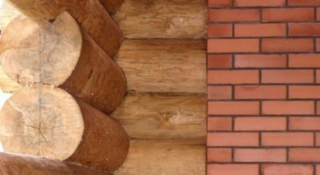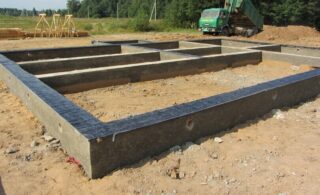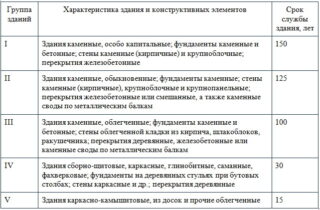Before starting construction, you need to decide whether to build a brick house or a wooden one. Each option is attractive in its own way, has its own advantages and disadvantages. The building will be erected for decades and should serve more than one generation, so the choice must be made in all respects thoughtful and promising. You should familiarize yourself with the features, strengths and weaknesses of each material, the rules for its installation and operation.
Advantages and disadvantages of brick and wood

The best way to determine which house is better, brick or wood, is to objectively assess the merits and demerits of both types of buildings. Both materials have a long history of use.
Benefits bricks:
- high strength, inaccessibility to intruders;
- fire resistance, incombustibility, preservation of properties at high temperatures;
- resistance to mold, mildew and insects;
- immunity to ultraviolet light;
- tolerance without damage to prolonged contact with a humid environment;
- long (100 years or more) service life, almost complete absence of shrinkage;
- no technological need for additional external finishing.
Negative sides:
- heaviness, the obligatory need for arranging a powerful and expensive foundation;
- high costs for laying walls, justified by the accuracy of the installation of small piece material;
- the ability to use only at positive temperatures and no precipitation;
- impossibility of repair in the event of cracks.

Positive sides wood:
- low specific gravity, there is no need for a powerful base;
- short terms for the construction of a log house, since the parts are large and cover the entire side of the house at once;
- lower cost of raw materials;
- the ability to use at any time of the year;
- excellent thermal insulation performance.
List of negative points:
- susceptibility to rotting and infestation by small insects;
- hygroscopicity, as a result of which regular special processing of wood is needed;
- tendency to shrinkage, deformation and formation of cracks;
- flammability, which can only be slightly reduced, but not completely eliminated.
With the right approach, the disadvantages of brick and wood can be minimized, and sometimes even zero.
Comparison of the main characteristics of materials
For ease of comparison, the main characteristics of materials are grouped in a table:
| Indicator | Wood | Brick |
| Microclimate quality | High. Absorbs excess moisture in damp weather and gives it back when warming. The comfort of living is provided in any weather. | Average. Does not conduct steam. With high humidity, condensation forms on walls, windows and ceilings. |
| Energy efficiency | High. The walls do not heat up and do not cool down. No need for constant heating and cooling. | Average. The material can hold the temperature for a long time, in the spring it needs to be heated for a long time, the walls have a great influence on the microclimate. |
| Appearance | Pleasant. Wood creates a sense of peace and home comfort. At the same time, there is no feeling of poverty in the project, but rather of patriarchy. | Restrained. The buildings look representative, sometimes rich. However, they are associated exclusively with such a concept as a capital construction object. |
| Comfort of stay | The tree looks good, creating a feeling of comfort, tranquility and coziness. It is always warm to the touch. It is easy to attach pictures and cabinets to the walls using nails and self-tapping screws. | A bare brick wall will appeal only to lovers of the Loft style. The surface of the stones is cold, you don't want to lean against it. For fasteners, you need a hammer drill and anchor bolts. |
| Repair suitability. | Decay of crowns in log cabins is quite common. There are technologies for their replacement with lifting, without lifting and partial disassembly of the building. | If there is a crack along the wall, to stop it, you need to repair the foundation and make a screed around the perimeter of the building. All this is expensive, but does not completely eliminate the problem. |
By most indicators, the leading position is occupied by log cabins and logs. We are not talking about frame structures or buildings made of foam blocks. Their strength characteristics are an order of magnitude lower, so there is no reason to make comparisons.
Description of the criteria for choosing a material
When choosing a project for the construction of a private house or summer cottage, you should pay attention to the technical characteristics of the materials, which are given priority.
| Indicator | Wood | Brick |
| Environmental friendliness | Higher. Raw materials do not contain carcinogens, toxins, toxic, radioactive and biologically active substances. | Average. Plasticizers and various preservatives are added to the massif and the solution. Let it be small, but the discharge is inevitable. |
| Thermal conductivity | Low. With a wall thickness of 25 cm, almost complete insulation from the outside temperature is achieved. Breakdown occurs only at values exceeding ± 30 ° C | High. To achieve good protection from external factors, a wall with a thickness of at least 50 cm is required, which is not typical for the private sector. The standard 25 cm is not enough. |
| Durability | Average. Depending on climatic conditions, it is 40-70 years old. Partial or complete replacement of damaged fragments is technologically possible. | High. The average is 100 years. In the event of structural defects, wall repair is impossible, only supporting measures through the foundation. |
| Strength | Average. It is impossible to destroy a wall manually, it can even withstand a collision with a motorcycle and a small car. At the same time, it does not present much effort to make a hole in the wall with a chainsaw. | High. Only reinforced concrete is stronger. To destroy a brick house, you will need heavy special equipment. The material tolerates light and strong impacts from hard objects without consequences. |
| Fire-fighting properties | Low. Wood belongs to the category of the most dangerous materials in this respect. Even the most effective flame retardants do not provide a guarantee against fire. | High. The brick does not burn and is an effective protection against the spread of flame. The technology of its manufacture (firing) ensures its safety even after a fire. |
| The cost | Average. The profile is light, fits quickly, no finishing is required. The base is light, of any type. | High. You need a strong foundation, laying bricks is a difficult and time-consuming process. Insulation is usually required. |
In addition to taking into account purely technical indicators, you need to remember about such points as climatic conditions, precipitation level, wind strength and its direction, the priorities of people who will live in the house.
Which house to choose: brick or wooden

For those who are just going to build a house for themselves and have not decided on the choice, you should consider how much it will meet the generally accepted criteria:
- strength and reliability;
- durability, which will last for at least three generations;
- an ideal microclimate in all respects;
- minimum amount of care and maintenance;
- constancy of temperature and humidity;
- reasonable costs for heating and air conditioning;
- good thermal insulation characteristics and noise protection;
- compliance with landscape design and traditions accepted in the region.
If you have a sufficient amount of finance, you can build a two-story brick-wooden house, where the first level will be made of bricks, and the second from a log or bar. With this approach, all the pros and cons inherent in each material will be taken into account, and their shortcomings will mutually compensate for each other.








